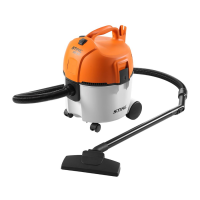SE 61
English
6
If an extension cord is coiled on a cord
reel, always unroll completely to reduce
the risk of fire due to overheating.
When using extension cords, the
connector and coupling must be
waterproof or routed in such a way that
they cannot come into contact with
water.
Transporting the vacuum cleaner
Before transporting the container, close
all the locks.
When transporting your unit in a vehicle,
properly secure it to prevent turnover
and damage to the vacuum cleaner.
Do not tilt the vacuum cleaner if there is
liquid in the container.
Do not use a crane hook to lift the
vacuum cleaner.
Before using
Always make sure the vacuum cleaner
is in proper condition before starting.
Working Conditions
Warning!
Inspect the power supply cord, exten-
sion cords and plugs before and after
each use for signs of damage or ageing.
Never operate your vacuum cleaner
with damaged cords or plugs.
Warning!
Never use the vacuum
cleaner to pick up hot
materials (hot ash, glow-
ing cigarette butts,
matches etc.). Never vac-
uum flammable or
combustible liquids (gasoline, thinner,
etc.) as well as aggressive liquids
(acids, lye) – Risk of serious or fatal
injury from fire or explosion!
Warning!
To reduce the risk of per-
sonal injury from fire and
explosion, never attempt
to vacuum flammable
explosive dust (e.g. mag-
nesium or aluminium
dust, etc.)
Warning!
To reduce risk of personal injury or
death, do not vacuum hazardous or
toxic material.
Warning!
Some dust created by sanding, ginding,
drilling and other workshop activities
contains chemicals known to the State
of California and other authorities to
cause cancer and birth defects and
other reproductive harm. Some exam-
ples of these chemicals are:
1. lead from lead-based paint
2. crystalline silica from bricks and
cement, other masonry products
and many types of stone, and
3. arsenic and chromium from chemi-
cally treated lumber.
If these or similar dusts are on the sur-
faces where you are cleaning, small
particles may become airborne as a
result of the vacuuming process. Con-
trol dust at the source where possible.
Use good work practices. When the
inhalation of dust cannot be substan-
tially controlled, i.e., kept at or near the
ambient (background) level, the opera-
tor and any bystanders should wear a
respirator approved by NIOSH/MSHA
for the type of dust encountered.
Warning!
If the substance being vacuumed is a
commercial substance, review, under-
stand and follow all warnings and
instructions in the product literature and
material safety data sheet for that sub-
stance and/or consult the material
manufacturer/supplier.

